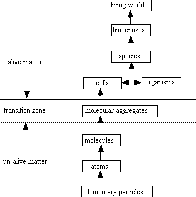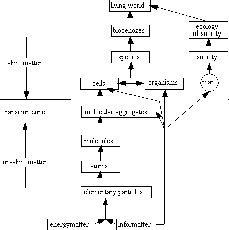Could thisnot be the same informaterial principle that we imagined before?
If so, then it can not be bestowed by somebody, but it has to
be born from the very constituents of the living molecular organism,
it must have some relation with its atoms or even with its elementary
particles. (We believe that it is here, within them, that some
principles apply that are different from those of the quantic
world; they could be principles of the sub-quantic world, principles
of the depth of the material world.) Then we could believe that,
in certain situations of complexity of organization of the un-alive
matter, the interaction of the component atoms and even of the
elementary particles, internal principles of the elementary particles
are also put into play. And it is possible that one of these principles
has an informational nature, i.e. it is derived from informatter.
The informational principle is valid in itself, but any information
must be connected with a material support, and in depth by informatter
(the latter has a characteristic of continuity since we consider
it to be of mental type, and it is not necessary to bring anything
primordially divine in the depths of the existence.) A space-time
material complex like the virus, for example, could have associated
to it an informaterial continuum giving unity to the organism,
continuum resulting from the nature of the material structure
of the respective aggregate of molecules. Hence the living matter
would have a double organization, first a discrete atomo-molecular
structure, secondly a continuous informaterial structure; both
structures are material, but their self-created combination could
explain the unitary quality of the molecular aliveness. The
virus is alive without consciousness, it is alive through the
sensitivity of its unity, a sensitivity of material nature.
The fact that the virus cannot live independently
does not constitutes an impediment to the above described model.
As any organism, it requires a certain type of environment; it
might be even possible that, for physical reasons, the informaterial
structure of the virus can only develop inside the cell. It is
well known the role played by water in everything that refers
to what is alive: it might be possible that a certain structuring
of water in the cell can favour the triggering of informaterial
structures, hence of the virus and not only of them. The biologist
confer a great importance to water in understanding life. A. Szent-Gyorggy
(The Bioenergetics, Bucharest, Ed. Stiintifica, 1962,
in Romanian) considers that water is structured in the cell like
"liquid ice". Eugen Macovschi (works on biostructure)
also give a large importance to water, searching in living units
a "biostructure" that could perhaps find a certain justification
in our model described above; even Henri Coanda (private communications)
was studying the structure of water in relationship with the phenomenon
of life. On the other hand, it could be possible that phenomena
related with cell membrane are playing just as an important role.
Whatever the concrete physical model, our
above mentioned model is one of principle; it is meant to explain
the qualitative jump from lifeless to alive. But the alive could
not appear possible by considering organization, feed-back and
selfadjustment alone; it is the associated informaterial structure,
the bi-structural organization that makes it seem possible.
Among the elements that Prof. N. Botnariuc
retains as fundamental for biological sciences (organization,
system, feed-back, information, program integration, etc.) a major
place is given to the hierarchy of biological systems. His scheme
(Fig. 30) is based on the linear hierarchy established by P. Weisz
(The science of biology, New York, McGraw Hill, 3rd Edition,
1963) completed with the observation (done also by Weisz) that
in fact it is more complicated than simple linearity.

Fig. 30
Considering our philosophical model we put
forward the extended scheme presented in Fig. 31.
The unity of the cell is ensured by an unique
principle of life; hence both the cell and the organism should
each have an informaterial global structure. The unity of a cell
is ensured by its whole body, membrane included. It is quite possible
that the cellular liquid (that embraces from the interior all
the cell elements) determines its unity. The dynamics of the
molecular-informaterialbi-structure (provided our model is correct) should also
be subjectedto some experiments, possibly using the viral elements and their
equivalents. An explanation should also be found to the unity
of any living organism as well as to the brain based unity of
animal. In this latter case it might be possible that the extracellular
(extraneuronal) liquid plays a certain role (besides the cellular
liquid) regarding the nervous cells.

Fig. 31
The unity of the alive, provided by the informaterial
field, could completely explain the integrative activity of organisms,
starting from the most elementary life forms and searching for
the role of the informaterial factor even at the higher hierarchicallevels.
Whenever life is looked at from the biological
viewpoint the temptation appears to reduce everything to the biological
aspect; eventually this happens even to the activity of the human
society. Nevertheless, the biological aspect is fundamental for
the human species too, and the economic aspect (as a social phenomenon)
is strongly connected to the biological aspect since it provides
the material conditions for the life to take place. But the social
aspect overcomes the biological one through the nature of the
social relations, through the social consciousness that it generates,
through knowledge and through the philosophical human dimensions.
Our social consciousness is partly born out
of the biological aspect, filtered through the socio-economic
relationships. Other sources are the human thinking, the spiritual
life, the knowledge, all such factors that categorically overcome
the biological aspect. The man is no doubt determined by the social
relations, but the social derives partly from the biologic
and economic, and partly from the spiritual, from man's power
of creation. Such social dialectics results from the fundamental
human nature, from brain's character of material device having
a bi-structure, i.e. a system of neurons (and constitutive substances)
and the associated informatter. But the animal also has such bi-structure;
however the human is superior since its mental device is more
complex and since through this device it can rise above the biological
level towards the full height of its existence. And from there
it can bring, like Prometeus, the spark to generate his spiritual
and social life. The biological and economic aspects are and will
remain primary, and will always influence the social consciousness,
but the man also has his own resources that feed his social life.
For this reason the society cannot be viewed only as a system
since the biological hierarchy interacts with the human society,
and in the latter the system is added to the civilization.
Our idea is that the systemic biological concept
can be used between the lower limit (the most elementary unit
of living matter) and the upper limit (the social and human consciousness)
of the living world, but the way it is applied, especially towards
the limits, should be of outmost care.
Biology and Psychology in Relation with Awareness
70







